Disclaimer: This article may contain affiliate links. Clicking on them may earn Costa Rica Vibes a commission, at no extra cost to you. Thank you for your support!
Corcovado National Park: Guide for Day and Overnight Trips
Corcovado National Park is located on the Pacific Coast on the southern tip of Costa Rica on what is known as the Osa Peninsula.
The park is home to 3% of the entire biodiversity in the world. How insane is that?
In fact, National Geographic has described Corcovado National Park as “the most biologically intense place on Earth”.
The reason for this condensed area of biodiversity is because within the national park there are at least 13 different ecosystems. If you want to see an abundance of wildlife and do some nice hiking while in Costa Rica, this is the place to visit!
Corcovado National Park had been on our Costa Rica bucket list pretty much since we moved to this beautiful country. However, it took three years of living here before we made it down there from San Jose.
We had this notion that the drive was extremely long, but after visiting and realizing we could easily make the drive within six hours or a short flight, our opinion has completely changed. The park doesn’t need to be some impossible goal. It is actually very accessible and an amazing place to visit.
Alright, let’s get to the complete Corcovado National Park guide!
Corcovado National Park History
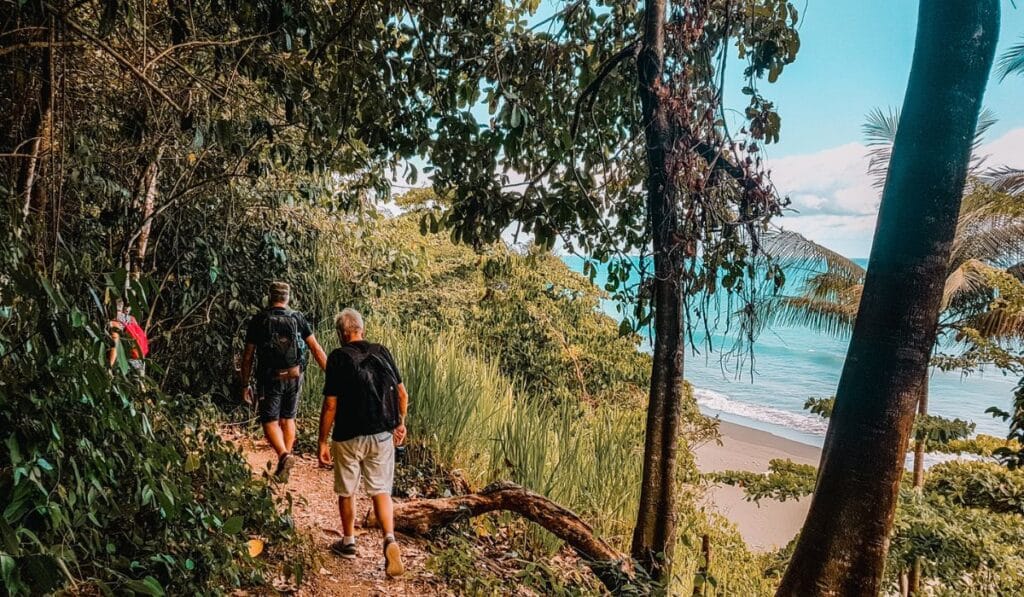
I am fascinated by the history of Corcovado National Park. I’m sure our guide the first time we visited was so annoyed by me. He was all about the wildlife and I just kept asking historical questions.
Anyway, the national park was officially established as a national park in 1975, but before that, there were several full communities in the area that now makes up the area of protected land.
The government ended up paying people to relocate so they could establish Corcovado. In fact, if you enter from the La Leona Ranger Station you can still see rusted old farming equipment, foundations for houses, and a cemetery.
I was just absolutely fascinated by this for two reasons. First off, can you imagine giving up your entire village for a national park?
I mean, it’s not like the people who lived here just had to move, the entire town was then destroyed. I’m not saying it’s a bad thing. I think it is great the Costa Rican government cared about preserving and building this amazing protected area, but I just can’t imagine what it was like for the people who lived there.
The second reason I was fascinated by this was that it is amazing to see how much nature replaced itself since 1975. Yes, 1975 was a long time ago, but to become such a rich and dense jungle in that amount of time was so interesting to me.
The other historical point that I found interesting is that some of the rivers within Corcovado National Park used to be used for gold mining. From the 1930’s until the 1980’s the area experienced a huge economic boom as a result of this mining.
On your hike ask your guide about the history of the area. Maybe you can get some more details. It’s pretty neat stuff!
Important Info About Corcovado National Park
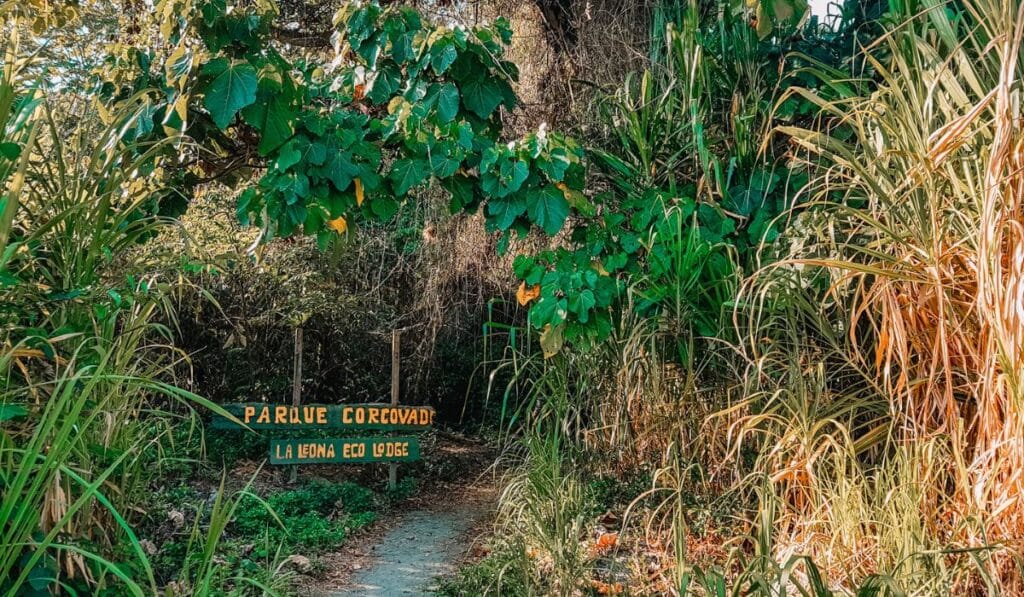
Access Points
There are three main access points for the national park with a total of four ranger stations.
If you come from Puerto Jiménez you will likely enter the park at the La Leona station. From Drake Bay, you will enter at San Pedrillo. The Los Patos station is only used for overnight or multi-day hikes.
You can click each point on the map to see the ranger stations. ↓
Hours
The park is open every day from 7am until 4pm.
Cost
The park entry for a day pass is $15 for adults, and $5 for children age 2- 12 years old. If you are a Costa Rican resident the entry fee is ¢1,600 for adults and ¢500 for children.
However, you can not access the national park without a guide. This means you will have to hire a private guide or organize your hike through a company. Due to this factor, your cost for visiting the national park will vary based on how long of a tour you do and which company you go with.
We get into this further in this article and provide some great tour options.
Directions
Most tour companies will give you the option of driving yourself to the start of the hike or riding with them. You will pay more (it varies by company) if you use their transportation.
If you opt to drive yourself you really do not have to worry much about directions. Most of the tour companies will have you meet them at a designated spot and you will follow them to the start of the hike.
Just keep in mind that you will need a car with 4 wheel drive. The roads to the national park are not paved and you will have to drive through rivers.

Adobe Rent-a-Car
- 10% discount for Costa Rica Vibes readers
- Free second driver
- 0% deductible on Liability Protection Insurance
- Excellent customer service
- New fleet of well-maintained vehicles
Parking
To park at the La Leona parking lot cost $5 per car. I, unfortunately, do not know what it costs to park at the other entry points. The tour company you go with can tell you that though.
Facilities
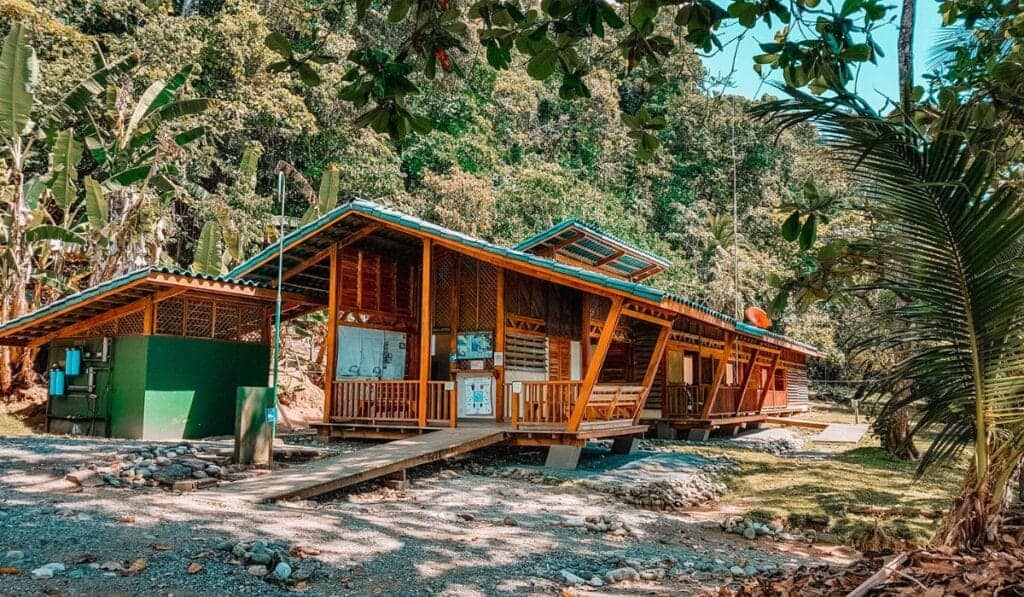
Each ranger station is equipped with potable water and bathroom facilities. The Sirena ranger station is used for overnight stays. It is also equipped with a campground, a dining hall, sleeping bunks, and showers.
What to Wear
For the day hike we did, I (Sarah) wore shoes that were similar to Keen, sport shorts, a fast drying t-shirt, sunglasses, and a baseball hat. Thomas wore pretty much the same thing.
If we visit Corcovado again there are a few things I would have done differently as far as my wardrobe choices.
- I wish I had a more lightweight hat. Wearing a baseball cap just got way too sweaty after a while but I really wanted to keep it on anyway because the sun was so strong.
- I would have worn longer shorts for hiking. I was so sweaty and longer shorts definitely would have been more comfortable.
Our tour company told us we could wear or bring our bathing suits if we wanted to swim. We brought our bathing suits and a towel but we did not end up using them at all.
Although it was extremely hot nobody else was swimming and we didn’t really want to go through the hassle of changing, getting all wet, and changing again.
What to Bring
– Lots of water is a necessity! We brought about three liters each. If you are entering from the La Leona ranger station you can fill up your bottles with potable drinking water there.
– Most day tours will require you to bring your own lunch. We packed plenty of food and I must say it was nice to have some snacks with electrolytes throughout the day. If you are staying in Puerto Jimenez there is a big grocery store called BM where you can buy things like granola bars, fruit, things for sandwiches etc.
– We packed our own binoculars. Your guide will have a telescope, but it is always nice to have your own binoculars especially if you are with a large group.
– Definitely pack sunscreen and bug spray. We didn’t have much trouble with bugs, but I can imagine that during the rainy season it is much worse. Also, the sun is extremely strong here so coat yourself in that SPF 50.
– We packed flip flops to put on once we finished our hike and I must say that taking off my hiking shoes at the end felt so incredibly nice.
Check out our Full Costa Rica National Park Packing List on Amazon for everything you need!
Best Time to Visit
It is best to visit Corcovado in the dry season (end of December until end of April). There are two reasons for that. The first reason is so that you won’t have to worry about rain disrupting your hike. The second reason to visit during the dry season is that the rivers are much lower during this time and easier for you to drive through.
However, if you visit during the rainy season there will be fewer people in the park and you can usually get some good off-season discounts from the local tour companies.
Our tour guide said that they do overnight hikes all year round but I also saw online that the Sirena ranger station is closed every year in October. If you plan to visit in October and would like to do an overnight hike it is best to check in with some tour companies first to see if that is possible.
Wildlife
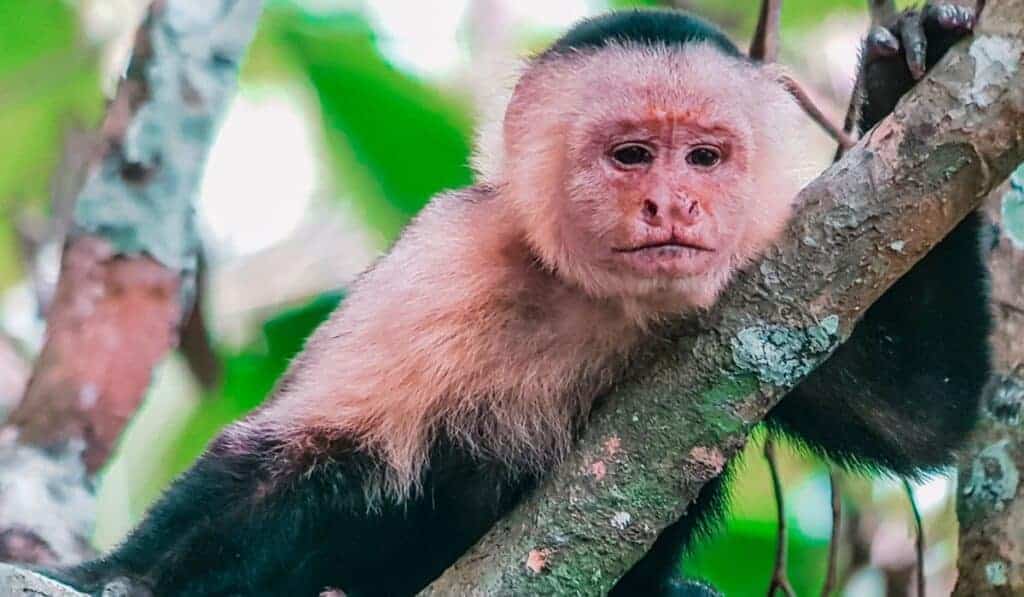
As I mentioned before, the national park is extremely rich in biodiversity. It is also home to over 370 species of birds, 140 mammals, 116 amphibians and reptiles, and over 6,00o types of insects. In other words, there is a lot of wildlife to see in the national park!
Just a few of the animals you may see include; capuchin monkeys (this is the white-faced monkey pictured above), howler monkeys, squirrel monkeys, spider monkeys, sloths, jaguars, pumas, ocelots, tapirs, anteaters, deer, coatis, sea turtles (leatherback, olive ridley, loggerhead and Pacific green turtles), crocodiles, iguanas, snakes, dart frogs, hummingbirds, scarlet macaws, parrots, and hawks.
Amazing, right?
The Corcovado National Park Hike
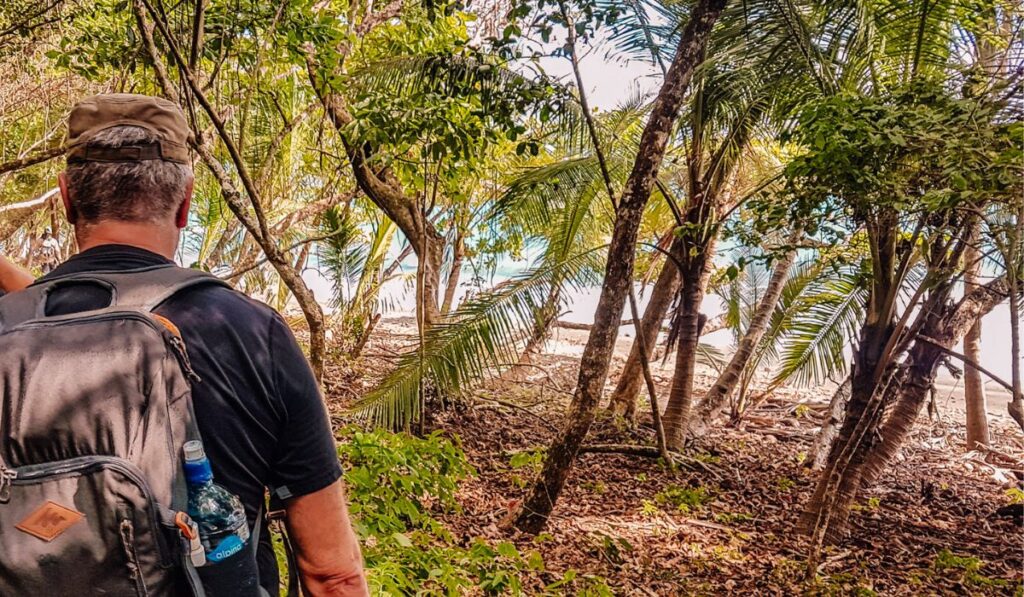
There are so many different hike options in Corcovado!
Day Hikes
You can take a day hike from Puerto Jimenez and enter at the La Leona station. You can also take a day hike from Drake Bay and enter at the San Pedrillo station. These day hikes are not overly strenuous but the heat definitely adds a level of challenge to the hike.
Multi-day Hikes
It is possible to enter at La Leona or Los Patos and hike to the Sirena Ranger Station. Unfortunately part of the trail from San Pedrillo ranger station (in Drake) is no longer open to the public.
If you want to take a multi-day tour from Drake you will have to take a boat in and out to the Sirena station.
All multi-day tours sleep at the Sirena Ranger Station. This ranger station has showers, potable water, and bathroom facilities.
The Sirena station is outfitted with bunk-style sleeping arrangements for $30 per person. You can opt to bring your own tent and pay $4 to stay in the camping zone.
Breakfast at Sirena is $20, lunch $25, and dinner is also $25.
Corcovado Tour Companies
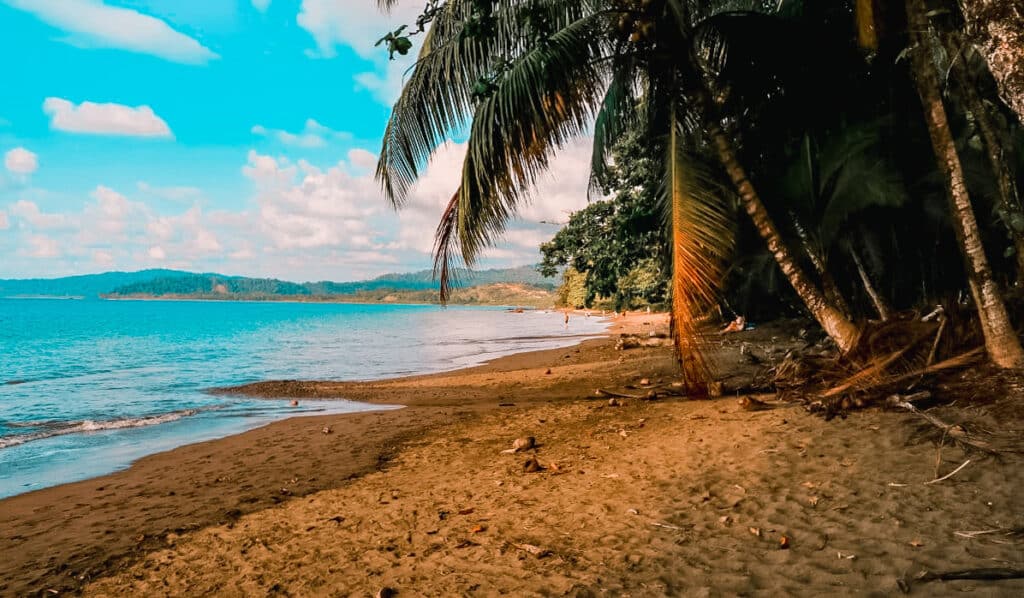
As I mentioned above, it is required that you visit Corcovado National Park with a certified guide. It is illegal to enter the park without a guide.
There are plenty of companies which offer tours within the national park. These tours typically start in Puerto Jimenez, Drake Bay, or from Sierpe.
Our First Experience at Corcovado National Park
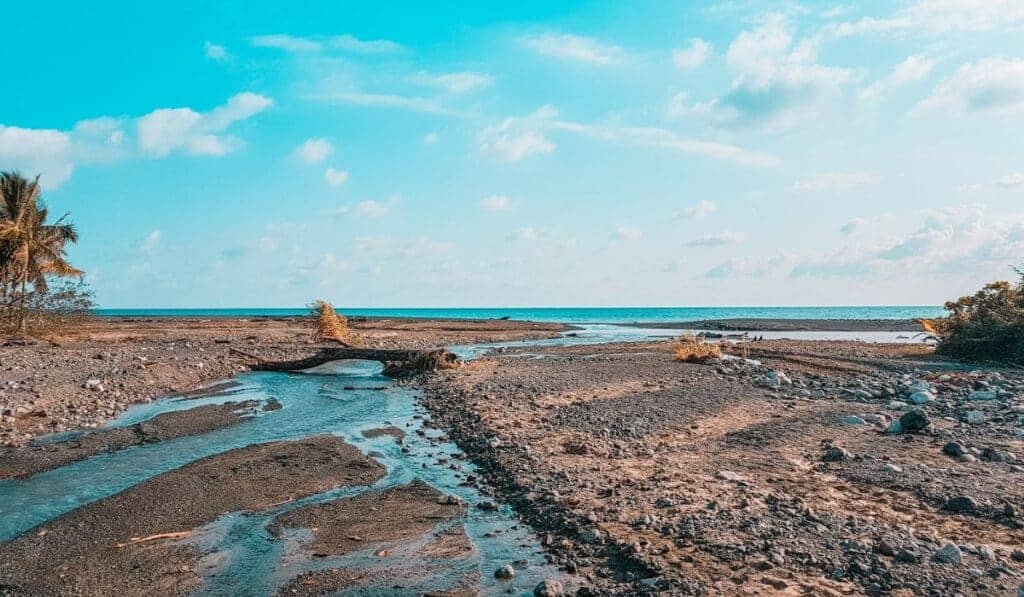
I’ll be honest, I was kind of worried before our day hike in Corcovado. It’s not like I’m in bad shape or anything, but the thought of hiking all day was a bit daunting to me. I worried that we would be with a group of experienced hikers and I would be the one to pull everyone down.
We had arranged our tour the day before from Puerto Jimenez.
On the morning of the tour we got up around 4:30am to meet our tour group at 5:20am in downtown Puerto Jimenez. I was happy to see that Thomas and I were the youngest people in our six-person tour group by a good twenty years or so.
Along the drive from Puerto Jimenez to where we would begin our hike, we stopped several times to see wildlife. Upon arriving we all loaded up on sunscreen and began the hike.
Our tour guide was excellent. He was so knowledgeable and you could just tell how passionate he was about Corcovado and the wildlife there.
The first two miles or so of the hike were not actually in the national park, but rather a trail to get to the entrance of the national park. The trail was well maintained, shady, and most importantly it was flat!
Upon arriving at the La Leona Ranger Station we were greeted by nice bathrooms, potable water, and outdoor showers. This ranger station is really nice and our guide said it had just been redone a few years ago.
After a brief stop at the ranger station, we continued for about another two miles. This trail was also well maintained, shady, and flat.
Thomas always says I have an adrenaline problem and it is so true. I always get nervous about doing certain activities but once I get started I’m ready to go all in. I’ll be honest, I could have hiked all the way to the Sirena Ranger Station at that point. I was all about it!
Anyway, after continuing for another two miles we stopped for lunch on a shady beach. This seemed to be the go-to lunch spot as there were several other tour groups there as well. After lunch, we continued a little further before turning around and heading back. We made it back to the car around 3:30 pm.
It was a long day, but really the hike was very manageable. We stopped probably every ten minutes or so to look at wildlife on the hiking trail which made it even more relaxed.
On our hike, we saw tons of birds, anteaters, tons of coati, multiple types of monkey species, owls and more!
I asked our tour guide about jaguars and he said that he sees them once in about every twenty tours. That’s way more than I expected! We didn’t see any, but I hope at some point in Costa Rica we do.
Puerto Jimenez or Drake Bay?
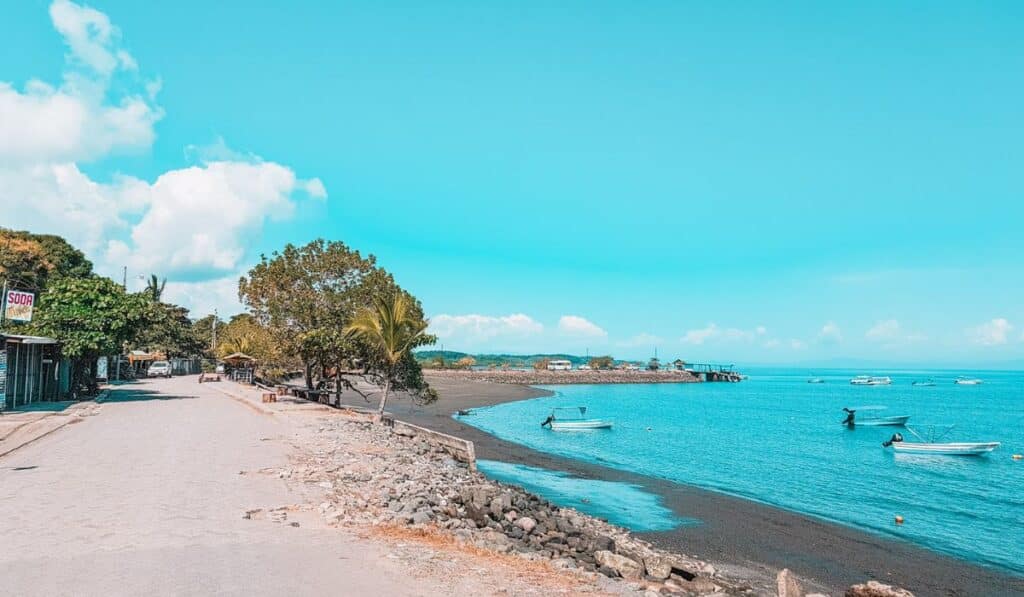
Now we get to the tough question, should you stay in Puerto Jimenez or Drake Bay for your Corcovado adventure?
Both small towns have their own charms and things to offer. I suggest Drake if you want a completely unique experience. It is the kind of town you won’t find anywhere else in the world. However, it is really remote and there is not much to do there besides visit the national park or surf. Plus, it is kind of difficult to get to.
For more action and an easier drive, Puerto Jimenez is the way to go!
Here is a map so you can get a better idea of where each town is located.
You can check out our guide to Puerto Jimenez and guide to Drake Bay for more info on transportation, hotels, activities, restaurants, and more!
Multi-Day Guided Tours
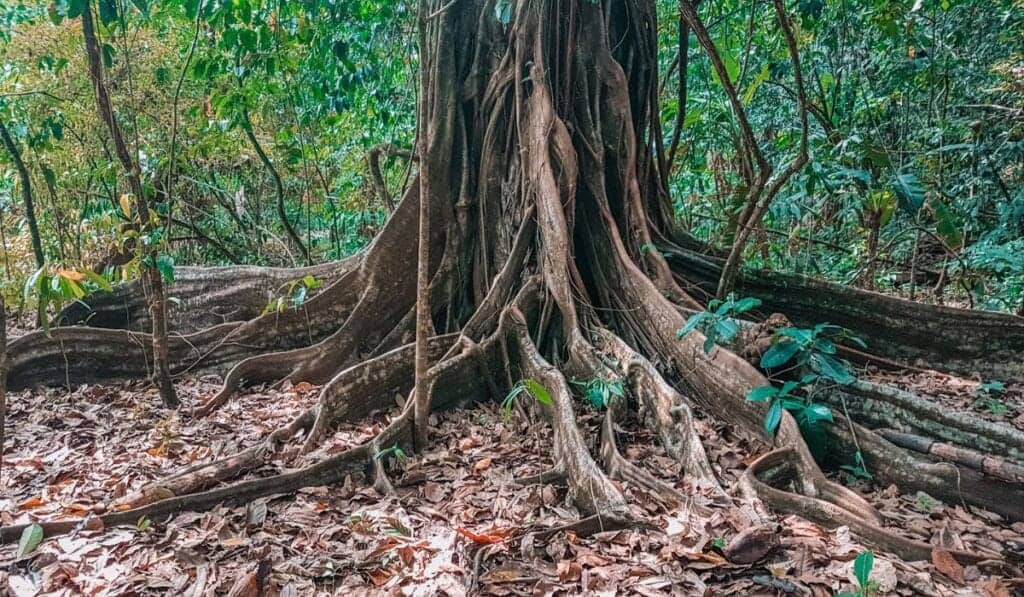
If you would like to do an extended Costa Rican tour that includes Corcovado, that is possible as well. Here are a few great options.
Costa Rica Pure Nature 10 Day Tour – A ten-day tour throughout the country with a focus on experiencing as much flora and fauna as possible.
Costa Rica Wildlife Exploration 14 Day Tour – A 14 days tour that starts and ends in San Jose. Some of the highlights of this tour include hiking at Rio Celeste, zip-lining in a cloud forest, taking an evening wildlife tour, and of course, visiting Corcovado National Park.
Corcovado Classic Experience 4 Day Tour – A four-day trip from San Jose to the Osa Peninsula. This tour includes a flight to Osa, one day of exploring Corcovado, and one day snorkeling around nearby Cano Island.
Helpful Tips for Your Corcovado National Park Visit
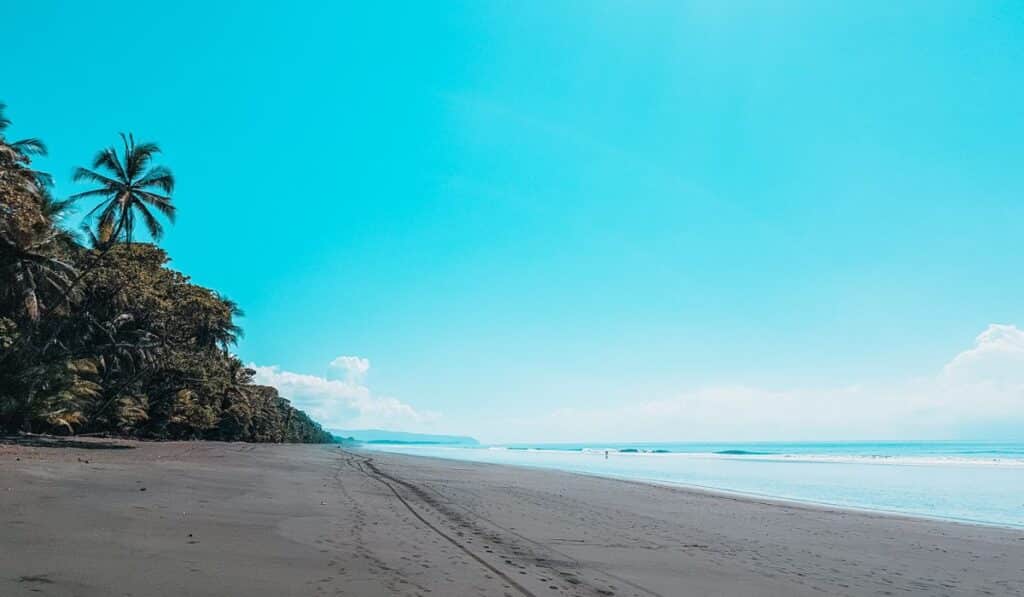
– We had no problem booking our tour the day before and that was during peak season. However, if you want to ensure that you get a place on a tour it is probably best to contact your tour company of choice ahead of time.
Also, if you do wait until the day before please keep in mind that the tour companies stop taking reservations by about 3pm because they have a deadline of when they can submit hiker’s names to the national park for the next day.
– Your guide will hopefully tell you this but, avoid touching trees or rocks when hiking. There are poisonous snakes in Corcovado. Also, some trees have spikes on them which you might not notice on first glance.
– Riptides are common in this area. Be careful if swimming.
– We, fortunately, didn’t see any, but our guide told us that African bees are a thing down here sometimes. If a swarm gets disrupted and is headed your way the best thing to do is to run in a zigzag pattern rather than straight ahead….at this point I feel like I am just instilling tons of fear in you. Sorry!
– If you need a good book to read check out, The Adventurers Son by Roman Dial. It is a memoir written by the father of a guy in his early twenties who disappeared in Corcovado National Park a few years ago.
I found the author (the father) to be a bit entitled. He focused the story a lot on himself instead of on his son, but still an interesting read.
– Drink water, water, and more water! Seriously, you’ll need it.
FAQ: Corcovado National Park
Is Corcovado National Park worth visiting?
Yes, it is definitely worth visiting. The park is in a remote area, so it is not the easiest to get to. However, despite that, the abundance of flora and fauna make it worth the trip.
Can you stay in Corcovado National Park?
Yes, with a guided tour you can stay overnight in Corcovado National Park. You will spend the night at the Sirene Ranger station in bunk-style accommodations.
What is the best month to visit Corcovado National Park?
Corcovado is best to visit during the dry season. In our opinion, January is a great time to visit because everything is still green. However, this is also peak tourism time.
How many jaguars are in Corcovado National Park?
The exact number is unknown, but it is believed that there are about 50 jaguars living in Corcovado National Park.
Conclusion
In conclusion, no matter if you visit Corcovado National Park for a day trip or multi-day hiking experience, you are bound to be impressed by the variety of flora and fauna in this park.
If you have any questions about planning your visit, don’t hesitate to ask in the comment section below. We are always happy to help you out!
You Might Also Like:
Costa Rica Travel Details: What You Need to Know
🚗 Should I rent a car in Costa Rica?
Having a rental car will give you the most flexibility when traveling in Costa Rica. This will also allow you to take fun day trips on your own.
- Save 10% Plus Other Perks with Our Adobe Rental Car Discount
- You might also consider; shared shuttle services or private transfer services
🏄🏽 How can I book things to do?
We find that Viator tends to have the most comprehensive selection of activities with secure booking and good cancellation policies.
🍍 I’m overwhelmed with planning. Can you help?
Of course! I suggest joining our Facebook group for specific questions and head to our Start Here Page to get started planning.
✈️ What is the best way to book a flight?
Usually, we have the best luck finding great prices with Skyscanner. Check for flights to both San Jose Airport (SJO) and Liberia Airport (LIR).
🛏️ What is the best way to book my Costa Rica hotels?
We highly suggest Booking.com for hotel bookings and typically use VRBO for Costa Rica vacation rentals.
🗣️What is the main language in Costa Rica?
The main language in Costa Rica is Spanish. Most people working in tourism speak at least some English.
💰 What is the currency in Costa Rica?
The currency used in Costa Rica is the Costa Rican colón (CRC). However, the US dollar is widely accepted in most tourist areas
📞 What is the best way to stay connected?
An eSIM from Airalo is the easiest way to get 4G data while traveling in Costa Rica.
🌴 Is Costa Rica safe?
Generally, Costa Rica is considered safe for tourists. However, like any travel destination, it’s best to use caution and be aware of your surroundings.
🛂 Do you need a passport to go to Costa Rica?
Yes, Costa Rica is its own country. You will need a passport to visit.
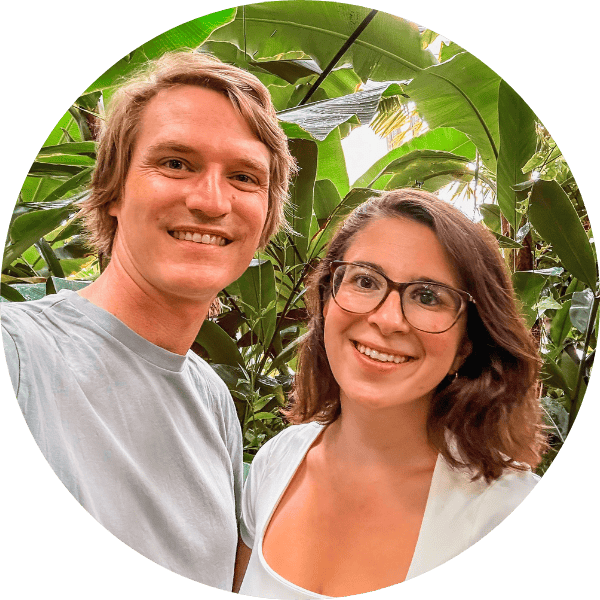
Hi! We’re Thomas (the German) and Sarah (the US-er)
We met in Virginia, moved to Germany, and since 2016 we have lived in sunny Costa Rica.
It was a spontaneous decision to move here, but it was the best decision!
Now we spend our days roaming the country to bring you the very best in Costa Rica travel here on Costa Rica Vibes.
Sarah is the writer. Thomas is the one keeping it all together.
Want the whole crazy story?

Sarah McArthur
Sarah McArthur is the co-founder and main writer of Costa Rica Vibes.
She is originally from the United States but has lived in sunny San Jose, Costa Rica since 2016.
She has traveled all over the country and now considers herself a self-proclaimed Costa Rica travel expert.
Want the whole crazy story?













